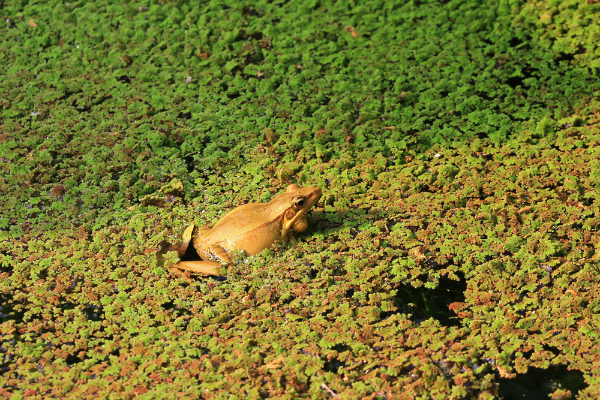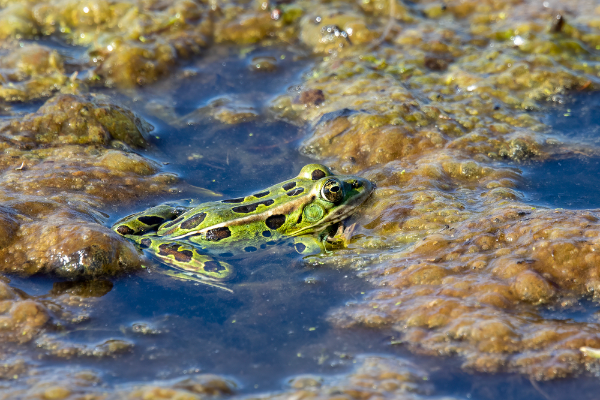The leopard frog is a common sight in the eastern United States, and can be found in a variety of habitats. These frogs are easily recognized by their characteristic spotted markings. They are generally peaceful creatures, but will defend themselves if necessary. Leopard frogs can be fun and interesting pets when properly cared for. In this blog post, we will discuss the care and feeding of leopard frogs. We will also explore some of the ways that these frogs can benefit your home environment. Keep reading to learn more about the Leopard Frog.

Leopard Frog Description
Leopard frogs are a type of frog found in North America. They get their name from the leopard-like spots on their back and sides. Leopard frogs are mostly green or brown, and they have darker spots on their body. Some leopard frogs also have a light line running down their back. Leopard frogs are medium-sized frogs and they can grow to be about 4 inches long. Leopard frogs are very good swimmers and they like to live near ponds, lakes, and marshes. Leopard frogs eat insects and other small animals. They sit and wait for their food to come to them, and then they snatch it up with their long tongue. Leopard frogs are also eaten by snakes, birds, mice, and other animals. People sometimes eat leopard frogs too. Leopard frogs are important because they help to control the populations of insects and other small animals.
Leopard Frog Habitat
Leopard frogs are found in a variety of habitats, from marshes and wetlands to grasslands and forests. They prefer areas with plenty of vegetation and water, as they need both to survive. Leopard frogs spend most of their time near water, as they require moisture to stay hydrated. In addition, they eat a variety of small invertebrates, which they find in the water or among the plants. Leopard frogs are also semi-aquatic, meaning that they can live both on land and in water. This allows them to inhabit a wide range of habitats, provided there is access to water. As a result, leopard frogs are one of the most widespread amphibian species in North America.
Leopard Frog Diet
Leopard Frogs are carnivores, and their diet consists mainly of small invertebrates such as insects, spiders, and worms. They will also occasionally eat small vertebrates such as baby mice. Leopard Frogs are ambush predators, meaning they will sit and wait for their prey to come to them before they strike. They have very long tongues that they use to capture their prey. Once the Leopard Frog has its prey in its mouth, it will swallow it whole. Leopard Frogs do not chew their food; they simply swallow it whole and digest it in their stomachs. Leopard Frogs are one of the few species of frogs that actually hunt their prey rather than simply waiting for it to come to them.
Leopard Frog Size
Leopard frogs are medium-sized frogs that can grow up to 6 inches in length. They are named for their spotted or leopard-like appearance, which is caused by dark spots on a light-colored background. Leopard frogs are found in a variety of habitats, from wetlands to grasslands, but they prefer areas with access to water. In terms of diet, leopard frogs will eat just about anything they can fit into their mouths, including insects, reptiles, and even other frogs. Leopard frogs are an important part of the ecosystem, and they are also popular pets. Unfortunately, leopard frogs are declining in numbers due to habitat loss and pollution. Hopefully, with proper conservation efforts, these fascinating animals will be around for many years to come.

Leopard Frog Lifespan
Leopard frogs are a species of frog that is native to North America. They get their name from the leopard-like spots that are found on their backs and legs. Leopard frogs typically have a lifespan of 4 to 5 years in the wild. However, their lifespan can be reduced to as little as 2 years if they are kept in captivity. Leopard frogs are an important species of frog, as they help to control populations of insects. They are also a popular pet, due to their docile nature and interesting appearance. Leopard frogs make a great addition to any reptile collection.
Leopard Frog Behavior
Leopard Frogs are a type of frog that is found in North America. They are named for their spots, which are said to resemble leopards. Leopard Frogs are semi-aquatic and can be found near ponds, streams, and marshes. They are mostly green or brown in color, with dark spots on their backs and sides. Leopard Frogs eat insects, spiders, and other small animals. They are nocturnal creatures and are most active at night. Leopard Frogs mate in the springtime. The female Leopard Frog will lay her eggs in the water, and the male Leopard Frog will fertilize them. The eggs will hatch into tadpoles, which will eventually turn into adult Leopard Frogs. Leopard Frogs usually live for 4-5 years in the wild.
Leopard Frog Speed
Leopard frogs are capable of jumping up to 10 feet in a single bound and can travel at speeds up to 4 miles per hour. They are also excellent swimmers, able to cross large bodies of water in search of prey or suitable habitat. When Leopard frogs feel threatened, they will often try to escape by running away quickly or hiding in dense vegetation. Their speed and agility make them difficult for predators to catch, and Leopard frogs have few natural enemies. In fact, their biggest threat is often humans, who can pollute or destroy their habitat. Leopard frogs are an important part of the ecosystem, and we must do our part to protect them.
Leopard Frog Hunting
Leopard Frog hunting is highly regulated in order to protect the populations of these animals. In some areas, it is only legal to hunt Leopard Frogs during certain times of the year. It is also important to obtain the proper permits and follow all other local regulations. When hunting Leopard Frogs, it is important to be respectful of their habitats. Avoid disturbing the surrounding area and be sure to properly dispose of any waste. Leopard Frogs are a valuable resource, and hunting them should be done in a sustainable manner.
Conclusion
The leopard frog is a great example of an animal that has adapted to its environment. Its coloration helps it hide from predators, and its long hind legs allow it to jump distances up to six feet. The leopard frog can also survive in cold climates, making it well-suited for the northern parts of North America.
Frequently Asked Question

